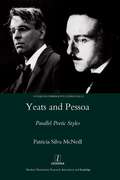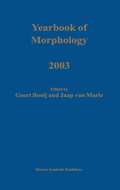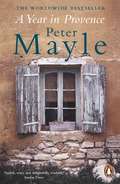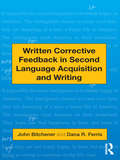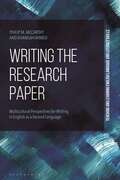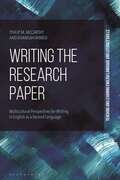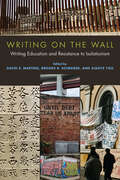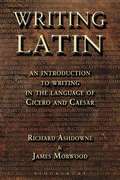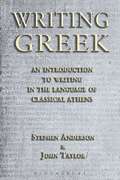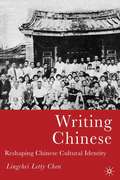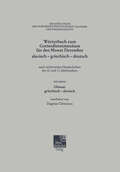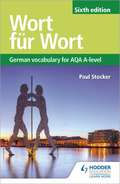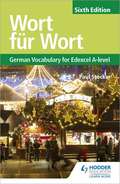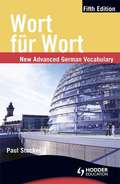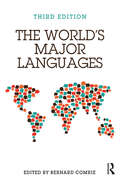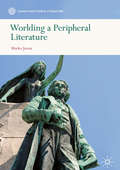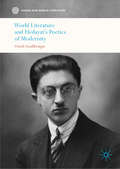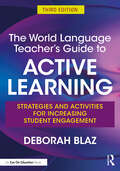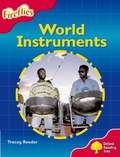- Table View
- List View
Yeats and Pessoa: Parallel Poetic Styles
by Patricia Silva-McNeillW. B. Yeats and Fernando Pessoa (1888-1935) regarded style as a tool for metaphysical inquiry and, consequently, they adopted distinct poetic styles to convey different attitudes towards experience. Silva-McNeill's study examines how the poets' stylistic diversification was a means of rehearsing different existential and aesthetic stances. It identifies parallels between their styles from a comparative case studies approach. Their stylistic masks allowed them to maintain the subjectivity and authenticity associated with the lyrical genre, while simultaneously attaining greater objectivity and conveying multiple perspectives. The poets continuously transformed the fond and form of their verse, creating a protean lyrical voice that expressed their multilateral poetic temperament and reflected the depersonalisation and formal experimentalism of the modern lyric.
Yeats and Pessoa: Parallel Poetic Styles
by Patricia Silva-McNeillW. B. Yeats and Fernando Pessoa (1888-1935) regarded style as a tool for metaphysical inquiry and, consequently, they adopted distinct poetic styles to convey different attitudes towards experience. Silva-McNeill's study examines how the poets' stylistic diversification was a means of rehearsing different existential and aesthetic stances. It identifies parallels between their styles from a comparative case studies approach. Their stylistic masks allowed them to maintain the subjectivity and authenticity associated with the lyrical genre, while simultaneously attaining greater objectivity and conveying multiple perspectives. The poets continuously transformed the fond and form of their verse, creating a protean lyrical voice that expressed their multilateral poetic temperament and reflected the depersonalisation and formal experimentalism of the modern lyric.
Yearbook of Morphology 2003 (Yearbook of Morphology)
by GEERT BOOIJ and JAAP VAN MARLEThe Yearbook of Morphology series, published since 1988, has proven to be an eminent support for the current upswing of morphological research and has set a standard for morphological research. The 2003 volume deals with the phenomenon of complex predicates consisting of a verb preceded by a preverb, presents historical evidence on the change of preverbal elements into prefixes, and discusses morphological parsing, and the role of paradigmatical relations in analogical change. It is relevant to theoretical, descriptive, and historical linguists, morphologists, phonologists, computational linguists, and psycholinguists.
A Year in Provence (Popular Penguins Series)
by Peter MayleThe bestselling, much-loved classic account of an English couple enjoying the fruits of French rural living - an irresistible feast of humour and heart.Peter Mayle and his wife did what most of us only imagine doing when they made their long-cherished dream of a life abroad a reality: throwing caution to the wind, they bought a glorious two hundred year-old farmhouse in the Lubéron Valley and began a new life.In a year that begins with a marathon lunch and continues with a host of gastronomic delights, they also survive the unexpected and often hilarious curiosities of rural life. From mastering the local accent and enduring invasion by bumbling builders, to discovering the finer points of boules and goat-racing, all the earthy pleasures of Provençal life are conjured up in this enchanting portrait.'One of the most successful travel books of all time... Mayle created a new travel genre' GuardianDelightful' Washington Post'Engaging, funny and richly appreciative' New York Times Book Review'Stylish, witty, delightfully readable' Sunday Times'I really loved this book' Julia Child
Written Corrective Feedback in Second Language Acquisition and Writing
by John Bitchener Dana R. FerrisWhat should language and writing teachers do about giving students written corrective feedback? This book surveys theory, research, and practice on the important and sometimes controversial issue of written corrective feedback, also known as “error/grammar correction,” and its impact on second language acquisition and second language writing development. Offering state-of-the-art treatment of a topic that is highly relevant to both researchers and practitioners, it critically analyzes and synthesizes several parallel and complementary strands of research — work on error/feedback (both oral and written) in SLA and studies of the impact of error correction in writing/composition courses — and addresses practical applications. Drawing from both second language acquisition and writing/composition literature, this volume is the first to intentionally connect these two separate but important lines of inquiry.
Written Corrective Feedback in Second Language Acquisition and Writing
by John Bitchener Dana R. FerrisWhat should language and writing teachers do about giving students written corrective feedback? This book surveys theory, research, and practice on the important and sometimes controversial issue of written corrective feedback, also known as “error/grammar correction,” and its impact on second language acquisition and second language writing development. Offering state-of-the-art treatment of a topic that is highly relevant to both researchers and practitioners, it critically analyzes and synthesizes several parallel and complementary strands of research — work on error/feedback (both oral and written) in SLA and studies of the impact of error correction in writing/composition courses — and addresses practical applications. Drawing from both second language acquisition and writing/composition literature, this volume is the first to intentionally connect these two separate but important lines of inquiry.
Writing the Research Paper: Multicultural Perspectives for Writing in English as a Second Language (Teaching and Learning English Language and Literacy Skills)
by Philip M. McCarthy Khawlah AhmedCovering both theoretical and practical approaches, Writing the Research Paper guides students studying in English as a second or additional language through the skills necessary for success in university-level writing and research. The book begins with theoretical considerations, such as research, argumentation and critical thinking. It then offers a broad range of practical assistance covering all aspects of the writing process, including topic selection, argument, counter-argument, paragraph structure and cohesion. The book is accompanied by a companion website, writingtheresearchpaper.com. The website hosts many features, including chapter summaries, exercises, quizzes, PowerPoints, additional learning material, and technology assistance. The website also hosts numerous authentic examples of student papers at each of the critical stages of the writing process.
Writing the Research Paper: Multicultural Perspectives for Writing in English as a Second Language (Teaching and Learning English Language and Literacy Skills)
by Philip M. McCarthy Khawlah AhmedCovering both theoretical and practical approaches, Writing the Research Paper guides students studying in English as a second or additional language through the skills necessary for success in university-level writing and research. The book begins with theoretical considerations, such as research, argumentation and critical thinking. It then offers a broad range of practical assistance covering all aspects of the writing process, including topic selection, argument, counter-argument, paragraph structure and cohesion. The book is accompanied by a companion website, writingtheresearchpaper.com. The website hosts many features, including chapter summaries, exercises, quizzes, PowerPoints, additional learning material, and technology assistance. The website also hosts numerous authentic examples of student papers at each of the critical stages of the writing process.
Writing on the Wall: Writing Education and Resistance to Isolationism
by Xiaoye You David S. Martins Brooke R. SchreiberThe first concerted effort of writing studies scholars to interrogate isolationism in the United States, Writing on the Wall reveals how writing teachers—often working directly with students who are immigrants, undocumented, first-generation, international, and students of color—embody ideas that counter isolationism. The collection extends existing scholarship and research about the ways racist and colonial rhetorics impact writing education; the impact of translingual, transnational, and cosmopolitan ideologies on student learning and student writing; and the role international educational partnerships play in pushing back against isolationist ideologies. Established and early-career scholars who work in a broad range of institutional contexts highlight the historical connections among monolingualism, racism, and white nationalism and introduce community- and classroom-based practices that writing teachers use to resist isolationist beliefs and tendencies. “Writing on the wall” serves as a metaphor for the creative, direct action writing education can provide and invokes border spaces as sites of identity expression, belonging, and resistance. The book connects transnational writing education with the fight for racial justice in the US and around the world and will be of significance to secondary and postsecondary writing teachers and graduate students in English, linguistics, composition, and literacy studies. Contributors: Olga Aksakalova, Sara P. Alvarez, Brody Bluemel, Tuli Chatterji, Keith Gilyard, Joleen Hanson, Florianne Jimenez Perzan, Rebecca Lorimer Leonard, Layli Maria Miron, Tony D. Scott, Kate Vieira, Amy J. Wan
Writing Latin
by James Morwood Richard AshdowneA completely new guide to writing Latin from scratch, this user-friendly book includes key features such as: broad coverage - all the major grammatical constructions of the Latin language are covered, reinforcing what students have learnt from reading Latin; thorough accessible explanations - no previous experience of writing in Latin assumed; hundreds of examples - clear accurate illustrations of the constructions described, all with full translations; over six hundred practice sentences - graduated exercises leading students through three levels of difficulty from elementary to advanced level;introduction to Latin word order - a brief guide to some of the most important principles; and, longer passages for practising continuous prose composition - more challenging passages to stretch the most able students.It also includes features such as: commentaries on examples of Latin prose style - passages from great Latin prose writers focus attention on imitating real Latin usage; and, complete list of vocabulary - all the words needed for the exercises and a valuable reference for English-Latin work in general.
Writing Latin
by James Morwood Richard AshdowneA completely new guide to writing Latin from scratch, this user-friendly book includes key features such as: broad coverage - all the major grammatical constructions of the Latin language are covered, reinforcing what students have learnt from reading Latin; thorough accessible explanations - no previous experience of writing in Latin assumed; hundreds of examples - clear accurate illustrations of the constructions described, all with full translations; over six hundred practice sentences - graduated exercises leading students through three levels of difficulty from elementary to advanced level;introduction to Latin word order - a brief guide to some of the most important principles; and, longer passages for practising continuous prose composition - more challenging passages to stretch the most able students.It also includes features such as: commentaries on examples of Latin prose style - passages from great Latin prose writers focus attention on imitating real Latin usage; and, complete list of vocabulary - all the words needed for the exercises and a valuable reference for English-Latin work in general.
Writing Greek: An Introduction to Writing in the Language of Classical Athens
by Stephen Anderson John TaylorPlanned as a companion volume to Writing Latin by Richard Ashdowne and James Morwood, this accessible guide to writing Greek is useful for anyone starting Greek prose composition. Part 1 deals with the constituent elements of the simple sentence, and in Part 2 all major constructions are covered, each with thorough explanations and clear examples. Each chapter has either two or three exercises of practice sentences, further supplemented throughout Part 2 by passages for continuous composition. 100 important irregular verbs with their principal parts are listed at the back of the book, and there is a complete vocabulary for all the exercises, a useful learning and revision resource in itself.
Writing Greek: An Introduction to Writing in the Language of Classical Athens
by Stephen Anderson John TaylorPlanned as a companion volume to Writing Latin by Richard Ashdowne and James Morwood, this accessible guide to writing Greek is useful for anyone starting Greek prose composition. Part 1 deals with the constituent elements of the simple sentence, and in Part 2 all major constructions are covered, each with thorough explanations and clear examples. Each chapter has either two or three exercises of practice sentences, further supplemented throughout Part 2 by passages for continuous composition. 100 important irregular verbs with their principal parts are listed at the back of the book, and there is a complete vocabulary for all the exercises, a useful learning and revision resource in itself.
Writing Chinese: Reshaping Chinese Cultural Identity
by L. ChenThis is a comparative study of the politics of Chinese cultural identity facing China, Taiwan, Hong Kong, the US-Chinese, and the Chinese diaspora in the West. The author challenges current discussions of hybridity and nationalism by contrasting the experiences of Taiwan, Hong Kong and US-Chinese with those of China and the Chinese diaspora.
Wörterbuch zum Gottesdienstmenäum für den Monat Dezember slavisch - griechisch - deutsch: nach ostslavischen Handschriften des 12. und 13. Jahrhunderts (Abhandlungen der Rheinisch-Westfälischen Akademie der Wissenschaften #8)
by Dagmar ChristiansWort für Wort Sixth Edition: German Vocabulary For Aqa A-level
by Paul StockerExam board: AQALevel: A-levelSubject: GeographyFirst teaching: September 2016First exams: Summer 2018Essential vocabulary for AQA A-level German, all in one place.- Supplement key resources such as course textbooks with all the vocab students need to know in one easy-to-navigate place, completed updated to match the latest specification - Ensure extensive vocab coverage with topic-by-topic lists of key words and phrases, including a new section dedicated to film and literature - Test students' knowledge with end-of-topic activities designed to deepen their understanding of word patterns and relationships - Develop effective strategies for learning new vocab and dealing with unfamiliar words
Wort für Wort Sixth Edition: German Vocabulary for Edexcel A-level
by Paul StockerExam board: EdexcelLevel: A-levelSubject: GermanFirst teaching: September 2016First exams: Summer 2017Essential vocabulary for Edexcel A level German, all in one place.- Supplement key resources such as course textbooks with all the vocab students need to know in one easy-to-navigate place, completed updated to match the latest specification - Ensure extensive vocab coverage with topic-by-topic lists of key words and phrases, including a new section dedicated to film and literature - Test students' knowledge with end-of-topic activities designed to deepen their understanding of word patterns and relationships - Develop effective strategies for learning new vocab and dealing with unfamiliar words
Wort fur Wort: New Advanced German Vocabulary (PDF)
by Paul StockerHelp your students impress examiners with authentic and sophisticated phrases. This book provides idiomatic phrases drawn from real sources such as newspapers, magazines and websites to ensure the most accurate and authentic language. Covers key vocabulary in thematic sections and with distinctions between levels of difficulty from AS to A2.nbsp; Easy for students to reference and search ahead of exams with topics matched to latest exam specifications.nbsp; Ensure students know the latest phrases and idioms with new entries for the latest development in communications and technology.nbsp; Increase students' repertoire with lists of synonyms.
The World's Major Languages
by Bernard ComrieThe World's Major Languages features over 50 of the world's languages and language families. This revised edition includes updated bibliographies for each chapter and up-to-date census figures. The featured languages have been chosen based on the number of speakers, their role as official languages and their cultural and historical importance. Each language is looked at in depth, and the chapters provide information on both grammatical features and on salient features of the language's history and cultural role. The World’s Major Languages is an accessible and essential reference work for linguists.
The World's Major Languages
by Bernard ComrieThe World's Major Languages features over 50 of the world's languages and language families. This revised edition includes updated bibliographies for each chapter and up-to-date census figures. The featured languages have been chosen based on the number of speakers, their role as official languages and their cultural and historical importance. Each language is looked at in depth, and the chapters provide information on both grammatical features and on salient features of the language's history and cultural role. The World’s Major Languages is an accessible and essential reference work for linguists.
Worlding a Peripheral Literature (Canon and World Literature)
by Marko JuvanBringing together the analyses of the literary world-system, translation studies, and the research of European cultural nationalism, this book contests the view that texts can be attributed global importance irrespective of their origin, language, and position in the international book market. Focusing on Slovenian literature, almost unknown to world literature studies, this book addresses world literature’s canonical function in the nineteenth-century process of establishing European letters as national literatures. Aware of their dependence on imperial powers, (semi)peripheral national movements sought international recognition through, among other things, the newly invented figure of the national poet. Writers central to dependent national communities were canonized to represent their respective cultures to the norm-giving Other – the emerging world literary canon and its aesthetic ideology. Hence, national literatures asserted their linguo-cultural individuality through the process of worlding; that is, by their positioning in the international literary world informed by the supposed universality of the aesthetic.
World Literature and Hedayat’s Poetics of Modernity (Canon and World Literature)
by Omid AzadibougarThis book introduces the canonical figure Sadegh Hedayat (1903–1951) and draws a comprehensive image of a major intellectual force in the context of both modern Persian Literature and World Literature. A prolific writer known for his magnum opus, The Blind Owl (1936), Hedayat established the use of common language for literary purposes, opened new horizons on imaginative literature and explored a variety of genres in his creative career. This book looks beyond the reductive critical tendencies that read a rich and diverse literary profile in light of Hedayat’s suicide, arguing instead that his literary imagination was not solely the result of genius but rather enriched by a vast network of the world’s literary traditions. This study reflects on Hedayat’s attempts at various genres of artistic creation, including painting, fiction writing, satire and scholarly research, as well as his persistent struggles for artistic authenticity, which transcended solidly established literary and artistic norms. Providing a critical reading of Hedayat’s work to untangle aspects of his writing – including reflections on science, religion, nationalism and coloniality – alongside his pioneering work on folk culture, and how humor informs his writings, this text offers a critical review of the status of Persian literature in the contemporary landscape of the world’s literary studies.
The World Language Teacher's Guide to Active Learning: Strategies and Activities for Increasing Student Engagement
by Deborah BlazEnhance your students’ success and improve the likelihood of retention with the easy-to-implement activities and strategies in this book! Bestselling author Deborah Blaz shows how to create a classroom in which students can actively experience and explore a world language. The new edition features updates in every chapter and incorporates the latest ACTFL standards, more information on teaching with authentic resources, a new chapter on teaching with technology, and additional resources for personalized learning. It is organized to allow you to easily find and pull activities you want to use in your classroom the very next day. You’ll learn how to… mix up your repertoire of activities, games, and exercises to keep students engaged; introduce students to the culture of the language you teach by hosting parties and celebrations; overcome some of the biggest obstacles in the path to fluency, including verb conjugation, using object pronouns, and the subjunctive mood; customize your teaching strategies to accommodate a broader range of talents, skills, and intelligences; implement new assessment strategies to improve verbal skills and reading comprehension; and more! Bonus: Downloadable versions of some of the resources in this book are available on the Routledge website at www.routledge.com/9781032258294 so you can print and distribute them for immediate classroom use.
The World Language Teacher's Guide to Active Learning: Strategies and Activities for Increasing Student Engagement
by Deborah BlazEnhance your students’ success and improve the likelihood of retention with the easy-to-implement activities and strategies in this book! Bestselling author Deborah Blaz shows how to create a classroom in which students can actively experience and explore a world language. The new edition features updates in every chapter and incorporates the latest ACTFL standards, more information on teaching with authentic resources, a new chapter on teaching with technology, and additional resources for personalized learning. It is organized to allow you to easily find and pull activities you want to use in your classroom the very next day. You’ll learn how to… mix up your repertoire of activities, games, and exercises to keep students engaged; introduce students to the culture of the language you teach by hosting parties and celebrations; overcome some of the biggest obstacles in the path to fluency, including verb conjugation, using object pronouns, and the subjunctive mood; customize your teaching strategies to accommodate a broader range of talents, skills, and intelligences; implement new assessment strategies to improve verbal skills and reading comprehension; and more! Bonus: Downloadable versions of some of the resources in this book are available on the Routledge website at www.routledge.com/9781032258294 so you can print and distribute them for immediate classroom use.
World Instruments - Oxford Reading Tree, Stage 4, Firelies (PDF)
by Thelma Page Gill Howell Mary Mackill Liz Miles Lucy Tritton Tracey Reeder Roderick HuntThis book is part of the Oxford Reading Tree Fireflies series which offer a wide range of stimulating non-fiction titles for young children. It includes a variety of topics covering all areas of the curriculum, from science to citizenship. The books have a bright modern page design, and are illustrated with colour photographs. They are carefully graded across 10 levels and contain built-in progression and vocabulary repetition throughout. Each book includes notes for parents/carers and teaching assistants on the inside covers. Help with childrens reading development is also available at www.oxfordowl.co.uk. This book is also available as part of a mixed pack of 6 different books or a class pack of 36 books of the same ORT level.
